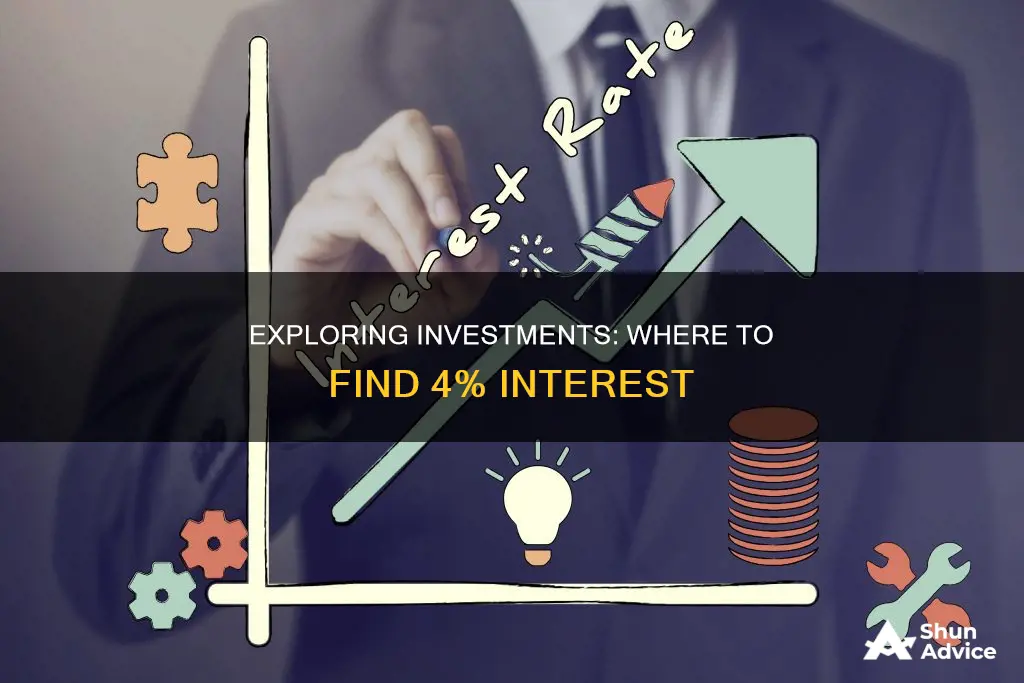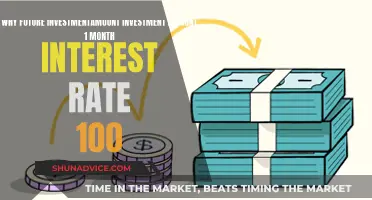
There are a number of investment options that can yield 4% interest or more. These include retirement stocks, bonds, and high-yield savings accounts. For those looking for low-risk investments, savings vehicles such as CDs (certificates of deposit) and savings accounts are a good place to start. CDs offer a higher interest rate than regular savings accounts, but you will need to maintain a minimum balance to receive the advertised interest rate. Bonds are also a good compounding investment option, as they allow you to loan money to a company or government and receive a specified yield in return.
| Characteristics | Values |
|---|---|
| Investment type | CDs (certificates of deposit) and high-yield savings accounts |
| Risk | Low |
| Access to money | Full access once the CD matures; high-yield savings accounts are accessible vehicles for your cash |
| Interest rate | Typically higher than a regular savings account |
| Term | Most often ranging from three months to five years |
| Early withdrawal | Possible, but may incur a penalty |
What You'll Learn

CDs (certificates of deposit)
If you're looking for an investment that will give you a 4% interest rate, one option to consider is CDs, or certificates of deposit. CDs are a type of savings vehicle that can offer a higher interest rate than a regular savings account, making them an attractive option for those seeking to grow their money with minimal risk.
When you open a CD, you agree to keep your money in the account for a specified period, typically ranging from three months to five years. In return, the bank pays you interest at regular intervals, and once the CD matures, you'll have full access to your funds. If you need to withdraw your money early, you may have to pay a penalty fee, but you'll still earn a little more interest than if you had kept your money in a standard checking account.
One of the advantages of CDs is that they offer a guaranteed rate of return. You know exactly how much interest you'll earn over the term of the CD, making it easier to plan and predict your financial future. This can be especially beneficial for those who are risk-averse or prefer a more conservative investment strategy.
However, it's important to note that CDs may struggle to keep up with inflation. While they can provide a steady and reliable return, the interest rates offered may not always outpace rising prices. As a result, investors seeking to stay ahead of inflation may need to consider more aggressive investment options or diversify their portfolios with other types of investments.
Despite this, CDs remain a popular choice for those seeking a low-risk way to grow their savings. They are particularly well-suited for beginners who want to take advantage of compound interest without taking on too much risk. By choosing a CD with a term that aligns with your financial goals and comfort level, you can boost your savings and gain financial confidence.
Investing vs. Debt: Navigating Interest Rates
You may want to see also

Savings accounts
There are two main types of savings accounts: traditional savings accounts and high-yield savings accounts. Traditional savings accounts typically have lower interest rates than high-yield savings accounts, but they may have more flexible terms. For example, some traditional savings accounts may not require a minimum balance to receive the advertised interest rate, while high-yield savings accounts often do.
High-yield savings accounts can be found at both online and brick-and-mortar banks. They are a good option for those who want to earn a higher interest rate on their savings. However, it's important to note that even high-yield savings accounts may have trouble keeping up with inflation.
Another option for savers is a certificate of deposit (CD). CDs require a minimum deposit and pay interest at regular intervals, typically at a higher rate than a regular savings account. The term of a CD can vary, most often ranging from three months to five years. Once the CD matures, you will have full access to your money. If you need the money sooner, you can select a shorter-term CD or pay an early withdrawal penalty.
Overall, savings accounts can be a good option for those who want to earn interest on their cash while maintaining easy access to their funds. However, it's important to carefully consider the terms and conditions of different savings accounts to find one that meets your needs and helps you stay ahead of inflation.
Invest Wisely: Dave Ramsey's Guide to Smart Investing
You may want to see also

Retirement stocks
As you get older, you can adjust your allocation to focus more on generating income and preserving your money. For example, at age 60-69, you might consider a moderate portfolio (60% stock, 35% bonds, 5% cash/cash investments). If you're 70-79, a moderately conservative portfolio (40% stock, 50% bonds, 10% cash/cash investments) is a good option. And if you're 80 or older, a conservative portfolio (20% stock, 50% bonds, 30% cash/cash investments) may be more suitable.
There are also retirement accounts that offer tax-advantaged compounding, which can help you build wealth over time. Additionally, you can invest in index funds, which are baskets of individual stocks that can provide strong returns without the need to invest in each stock individually.
If you're a beginner investor, you might want to start with lower-risk investments such as CDs (certificates of deposit) and savings accounts. CDs require a minimum deposit and pay interest at regular intervals, typically at a higher rate than a regular savings account. Savings accounts are also accessible and a good option for those who need to access their cash in the near future.
Car Loan Interest: An Investment Strategy?
You may want to see also

High-yield online savings accounts
If you're looking for an investment that will give you a 4% interest rate, you might want to consider a high-yield online savings account. These accounts are a good option for those who need to access their cash in the near future, as well as risk-averse investors who want to avoid the possibility of losing their money.
One option for a high-yield savings account is a certificate of deposit (CD). CDs require a minimum deposit and pay you interest at regular intervals, usually at a higher rate than a regular savings account. The term of a CD can vary, most often ranging from three months to five years. Once the CD matures, you will have full access to your money. If you need the money sooner, you can select a shorter-term CD to give you a little more interest than if your money was just sitting in a checking account, or you can pay an early withdrawal penalty.
While high-yield savings accounts and CDs will typically pay more than a traditional savings account, they may struggle to keep up with inflation. To stay ahead of surging prices, an investor may need to consider more aggressive options, such as bonds.
Interest Rates: Investment Incentives or Deterrents?
You may want to see also

Bonds
If you need to access your money sooner, you can select a shorter-term bond. This will give you a little more interest than if your money was just sitting in a checking account. However, if you need to withdraw your money early, you may have to pay a penalty.
Margin Interest Deduction: A Smart Investment Strategy?
You may want to see also
Frequently asked questions
Bonds.
Bonds are essentially loans that you give to a creditor, whether that's a company or government.
The creditor agrees to give you a specified yield in return for you buying the debt.
Yes, you will need to reinvest the interest paid on a bond in order to compound the interest.
There are a few risks associated with investing in bonds, including rising interest rates, a collapse in raw-material prices, and a recession.







